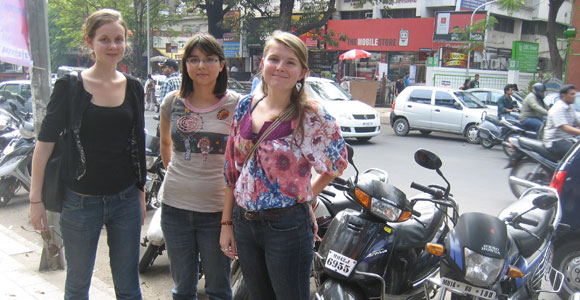
Marginalia
Cultural Survival
Story and photo by Elizabeth Station
This is an expanded version of the original print-edition article.
If you can eat a delicate masala dosa with your right hand and the steaming-hot potato filling doesn’t land in your lap, you’re golden. Over lunch with three students in the College’s South Asian Civilization program last fall, the Core got schooled about cultural difference in Pune, India.
Crossing to safety. “A street in India doesn’t look anything like a street in the US,” says Heather Lyon, ’14. “There are traffic lights, but you often have to cross where there isn’t one. … So you wait for a gap, and step out. The traffic kind of flows around you, but it’s a very jarring experience because it feels like everyone is going to hit you.” Her advice: “Follow locals when they cross the street. Make eye contact with drivers. Don’t risk anything. If need be, stand in the middle of the street for a while. That’s OK.”
Barefoot is best. Anna Karadzhova, ’13, likes the local custom of removing shoes before class, “or sometimes when you walk into a store or go into a place of worship. You feel very connected. It’s more familiar.”
You’ve been served. India’s solicitous culture can feel uncomfortable to self-service oriented Westerners. “When you go into a store, you let them bring their wares to you,” says Valerie Michelman, ’13. Students in the Pune program live in a business hotel and “the people who work there are wonderful—incredibly attentive and kind,” adds Lyon. “It’s their job, but it’s something we’re not used to.” Her response: “Be super nice and smile. The population here is so enormous that there’s an excess of labor. There are multiple people working every job, especially in lower-level positions.”
1.2 billion and counting. “Living in such a crowded place, everywhere you go, there are so many people,” says Karadzhova. Multiple generations live together and extended families provide a sense of support. What’s the downside? “Unlike in the US, it’s really hard to find a quiet place to read. You never get time to yourself.” And the upside? “Walking alone,” says Lyon, “if something were to happen—although I don’t think it ever will—there would always be someone to help you.”
Queue ED. ”Waiting in line, you’ve got to push your way to the front,” says Michelman. If you simply wait, “someone will push from behind to get ahead. That’s the custom.” She gleaned a technique from Suketu Mehta’s Maximum City that works in real life: “If you’re the next person in line, don’t stand behind the first person. Stand next to them.”
For more lessons from India, see "Follow the Music" in the Jan–Feb/12 issue of the University of Chicago Magazine.
